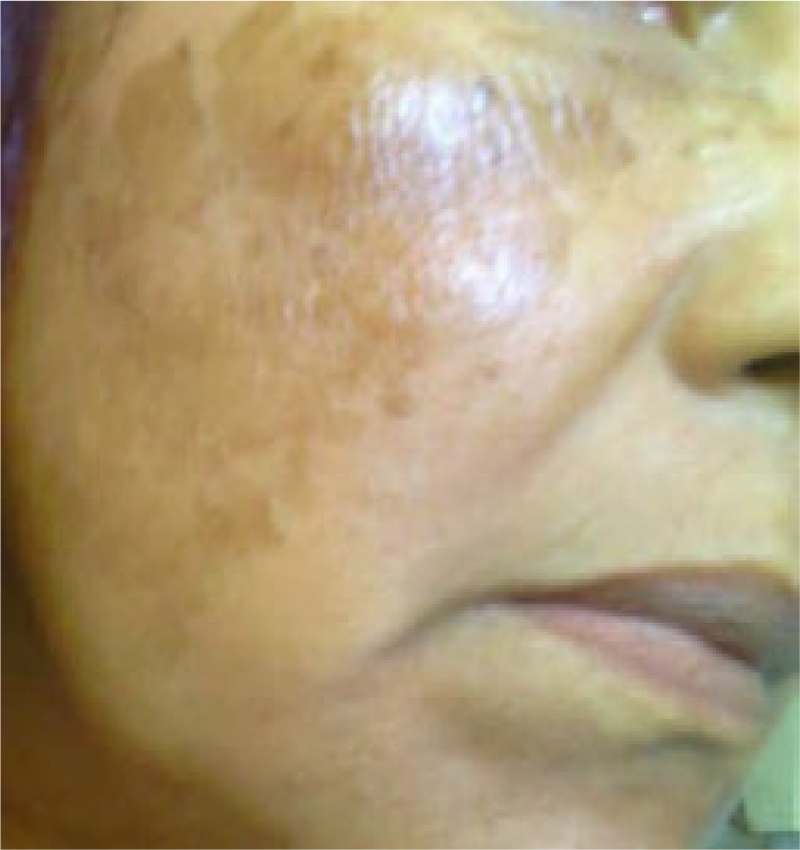EFFECTIVENESS OF AZELAIC PEEL IN THE TREATMENT OF MELASMA: A CASE REPORT
DOI:
https://doi.org/10.29176/2590843X.1535Keywords:
Azelaic acid, Dermoscopy, Melasma, Melanosis, ChemexfoliationAbstract
Melasma is an acquired, chronic, variable incidence hypermelanosis. It is characterized by macules located in areas exposed to the sun. It has been a pathology difficult to manage due to the low response to treatments, although chemical peels remain a key tool. Peelings based on azelaic acid, in concentrations greater tan 20%, produce an induced chemical peel, with progressive precipitation of epidermal proteins with minimal melanocytic reaction, antiproliferative and cytotoxic action in melanocytes, with inhibition of mitocondrial oxidoreductase activity and synthesis of DNA reduces hyperpigmentation by inducing desquamation and an inhibitory effect on tyrosinase. Dermatoscopy and trichromatic analysis facilitate the characterization and monitoring of dermatosis. The development of a protocol that allows the quantification, location, and distribution of the pigment, thanks to the calculation of pixels in each RGB channel, would be very useful to establish an appropriate treatment.
Author Biographies
Eva Páez
Residente de segundo año, posgrado de Dermatología, Ciudad Hospitalaria Dr. Enrique Tejera, facultad de Ciencias de la Salud, Universidad de Carabobo, Valencia, Venezuela.
Stephany Tobía
Residente de segundo año, posgrado de Dermatología, Ciudad Hospitalaria Dr. Enrique Tejera, facultad de Ciencias de la Salud, Universidad de Carabobo, Valencia, Venezuela.
Vivian Colmenárez
Residente de segundo año, posgrado de Dermatología, Ciudad Hospitalaria Dr. Enrique Tejera, facultad de Ciencias de la Salud, Universidad de Carabobo, Valencia, Venezuela.
Kathyuska Herrera
Residente de segundo año, posgrado de Dermatología, Ciudad Hospitalaria Dr. Enrique Tejera, facultad de Ciencias de la Salud, Universidad de Carabobo, Valencia, Venezuela.
Sandra Vivas
Jefa, servicio de Dermatología, Ciudad Hospitalaria Dr. Enrique Tejera, facultad de Ciencias de la Salud, Universidad de Carabobo, Valencia, Venezuela. Centro de Investigaciones Médicas y Biotecnológicas de la Universidad de Carabobo, Valencia, Venezuela.
References
Ocampo J, Rodríguez M, Silva M, Estrada L, Ortiz Y, Barba J, et al. Guías de diagnóstico y manejo de melasma. Dermatología CMQ. 2018;16(1):12-23.
Ai-Young L. Recent progress in melasma pathogenesis. Pigment Cell Melanoma Res. 2015;28(6):648-60. doi: 10.1111/pcmr.12404
Kang HY, Suzuki I, Lee DJ, Ha J, Reiniche P, Aubert J, et al. Transcriptional profiling shows altered expresión of wnt pathway- and lipid metabolism-related genes as well as melanogenesis-related genes in melasma. J Invest Dermatol. 2011;13(8):1692-700. doi: 10.1038/jid.2011.109
Juárez Jiménez M, Baena Bravo J. Melasma en atención primaria. Med Fam Andal. 2017;18(2):168-75.
Di Blasi R, Di Blasi S. Precipitación progresiva de las proteínas epidérmicas con mínima reacción melanocítica por medio de quimioexfoliación inducida por ácido azelaico. Tesis doctoral. Italia, SIES; 2008.
Stamatiadis D, Bulteau-Portois M, Mowszowicz I. Inhibition of 5alpha-reductase activity in human skin by zinc and azelaic acid. Br J Dermatol. 1988;119(5):627-32. doi: 10.1111/j.1365-2133.1988.tb03474.x
How to Cite
Downloads

Downloads
Published
How to Cite
Issue
Section

| Article metrics | |
|---|---|
| Abstract views | |
| Galley vies | |
| PDF Views | |
| HTML views | |
| Other views | |






